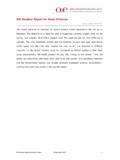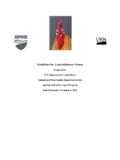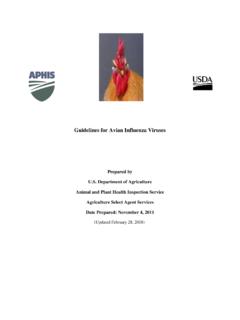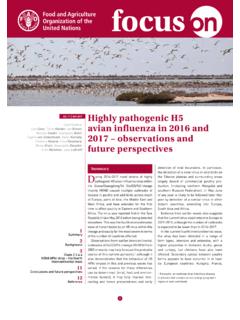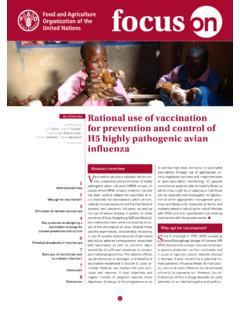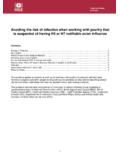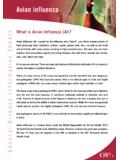Transcription of Laboratory Procedures Serological detection of …
1 Laboratory Procedures Serological detection of avian influenza A(H7N9) infections by microneutralization assay 23 May 2013 The WHO Collaborating Center for Reference and Research on influenza at the Chinese National influenza Center, Beijing, China, has made available attached Laboratory Procedures for Serological detection of avian influenza A(H7N9) infections by microneutralization assay. For further information please contact us at: WHO Collaborating Center for Reference and Research on influenza Chinese National influenza Center National Institute for Viral Disease Control and Prevention, China CDC 1 Serological detection of avian influenza A(H7N9) infections by microneutralization assay These Procedures were adapted from the WHO Manual for the Laboratory diagnosis and virological surveillance of influenza (Chapter 2G on page 63)1.
2 INTRODUCTION Serological methods rarely yield an early diagnosis of acute influenza virus infection. However, the demonstration of a significant increase in antibody titers (greater than or equal to 4-fold) between acute-phase and convalescent-phase sera may establish the diagnosis of a recent influenza infection even when attempts to detect the virus are negative. Apart from their retrospective diagnostic value, Serological methods such as virus neutralization and haemagglutination inhibition are the fundamental tools in epidemiological and immunological studies, as well as in the evaluation of vaccine immunogenicity.
3 The microneutralization assay is a highly sensitive and specific assay for detecting virus-specific neutralizing antibodies to influenza viruses in human and animal sera, potentially including the detection of human antibodies to avian subtypes. Virus neutralization gives the most precise answer to the question of whether or not an individual has antibodies that can neutralize the infectivity of a given virus strain. The assay has several additional advantages in detecting antibodies to influenza virus. First, it primarily detects antibodies to the influenza viral HA protein and thus can identify functional strain-specific antibodies in human and animal sera.
4 Second, since infectious virus is used, the assay can be carried out quickly once the emergence of a novel virus is recognized. Although conventional neutralization tests for influenza viruses (based on the inhibition of cytopathogenic effect formation in MDCK cell culture) are laborious and rather slow, a microneutralization assay using microtiter plates in combination with an ELISA to detect virus-infected cells can yield results within two days. The influenza virus microneutralization assay presented below is based on the assumption that serum-neutralizing antibodies to influenza viral HA will inhibit the infection of MDCK cells with virus.
5 Serially diluted sera should be pre-incubated with a standardized amount of virus before the addition of MDCK cells. After overnight incubation, the cells are fixed and the presence of influenza A virus 1 , accessed 23 May 2013 WHO Collaborating Center for Reference and Research on influenza Chinese National influenza Center National Institute for Viral Disease Control and Prevention, China CDC 2 nucleoprotein (NP) protein in infected cells is detected by ELISA. The absence of infectivity constitutes a positive neutralization reaction and indicates the presence of virus specific antibodies in the serum sample.
6 In cases of influenza -like illness, paired acute and convalescent serum samples are preferred. An acute sample should be collected within seven days of symptom onset and the convalescent sample collected at least 14 days after the acute sample, and ideally within 1 2 months of the onset of illness. A 4-fold or great rise in antibody titer demonstrates a seroconversion and is considered to be diagnostic. With single-serum samples, care must be taken in interpreting low titers such as 20 and 40. Generally, knowledge of the antibody titers in an age-matched control population is needed to determine the minimum titer that is indicative of a specific antibody response to the virus used in the assay.
7 The microneutralization protocol is therefore divided into three parts: Part I: Determination of the tissue culture infectious dose (TCID50). Part II: Virus microneutralization assay. Part III: ELISA. An overview of the microneutralization assay is showed in FIGURE 1 as below. FIGURE 1. WHO Collaborating Center for Reference and Research on influenza Chinese National influenza Center National Institute for Viral Disease Control and Prevention, China CDC 3 1. Materials required Equipments Class II biological safety cabinet. Water baths, 37oC and 56oC. Incubator, 37oC, 5% CO2.
8 Inverted microscope or standard microscope for the observation of cells. Automatic ELISA reader with 492 nm filter. Automatic plate washer (not essential but would be optimal). Low speed, bench top centrifuge. 4oC refrigerator. Freezer, - 70oC (for long term virus storage) or - 20oC (for serum storage). Supplies Cell culture flasks 96-well microtiter plates(flat-bottom) Haemacytometer and haemacytometer coverslips Cell counter Multichannel pipette and tips Pipettes Tubes Cell, media and buffers MDCK cell culture monolayer low passage (<25 30 passages) at low crowding (70 95% confluence) D-MEM high glucose (1x) liquid, with L-glutamine and without sodium pyruvate ( 11965-092) M PBS (pH )( 20012-43) HEPES buffer (1 M stock solution)( 15630-080) Citrate buffer capsules(Sigma P4922) Water (distilled and deionized) MDCK sterile cell culture maintenance medium(see below)
9 Virus diluent(see below) Wash buffer(PBST) Fixative solution(see below) Stop solution(see below) WHO Collaborating Center for Reference and Research on influenza Chinese National influenza Center National Institute for Viral Disease Control and Prevention, China CDC 4 Reagents Penicillin-streptomycin (stock solution contains 10000 U/ml penicillin; and 10000 g/ml streptomycin sulfate) 15140-122 200 mM L-glutamine 25030-081 Trypsin-EDTA ( trypsin; mM EDTA 4Na) 25300-054 Trypsin TPCK-treated (type XIII from bovinepancreas) T1426 o-phenylenediamine dihydrochloride (OPD) Fetal bovine serum (FBS) Invitrogen cat.
10 No. 10099-141 Bovine albumin fraction V (prepared as a solution in water) Roche,70250224 Trypan blue stain ( ) 15250-061 PBST Acetone Antibodies 1 -antibody: Anti- influenza A NP mouse monoclonal antibody (millipore, mixed A1,A3), dilute 1:4000 in blocking buffer or at optimal concentration 2 -antibody: Goat anti-mouse IgG conjugated to HRP(KPL), dilute 1:2000 in blocking buffer or at optimal concentration 2. Preparation of media and solutions MDCK sterile cell culture maintenance medium: DMEM, 10% FBS, P/S 440 mL Dulbecco s Modified Eagles Medium (DMEM) 5 mL 100 X P/S (100 /mL penicillin, 100g/mL streptomycin) 5 mL 200 mM L-glutamine 50 mL FBS FBS need to be heat-inactivated at 56 C for 30 min before use.










